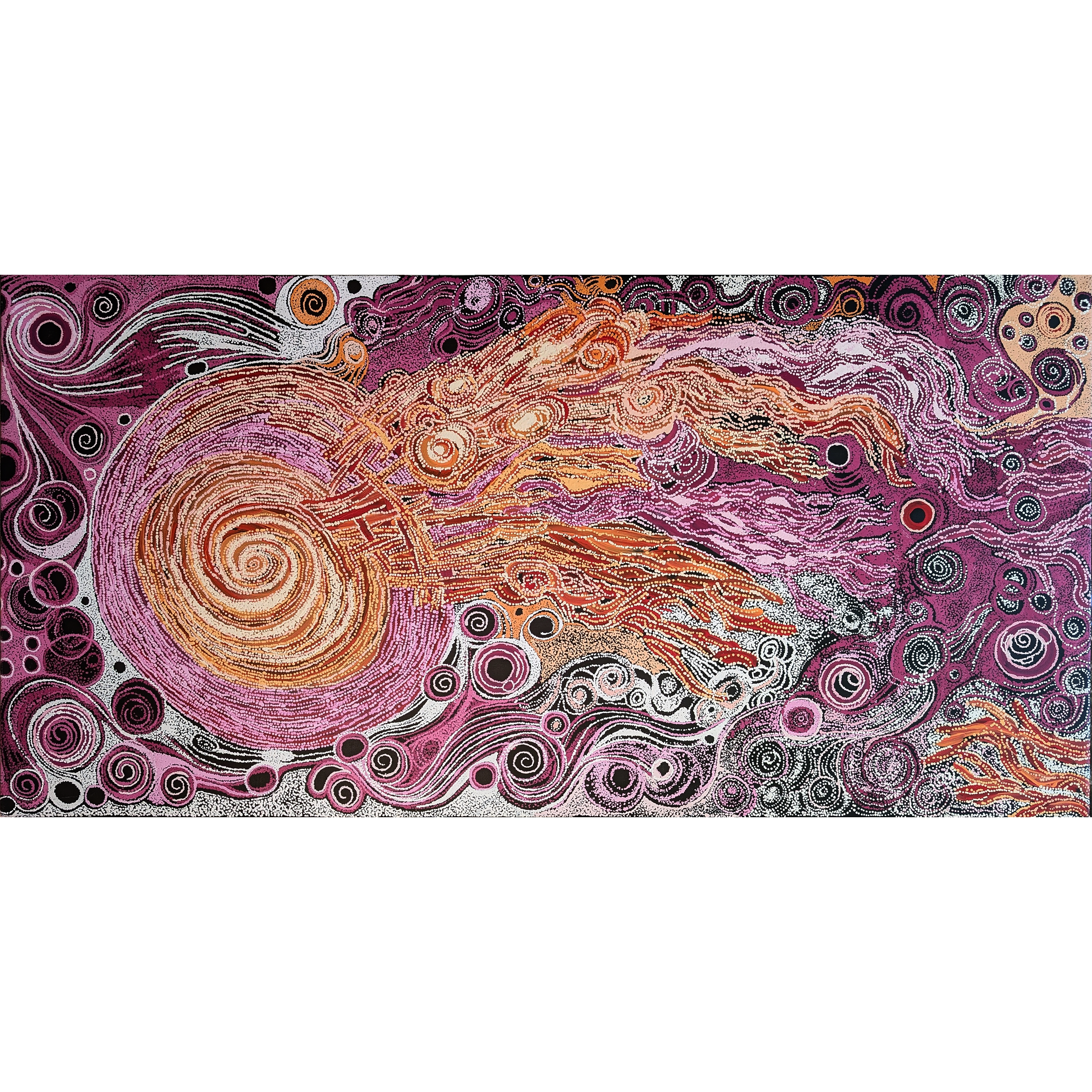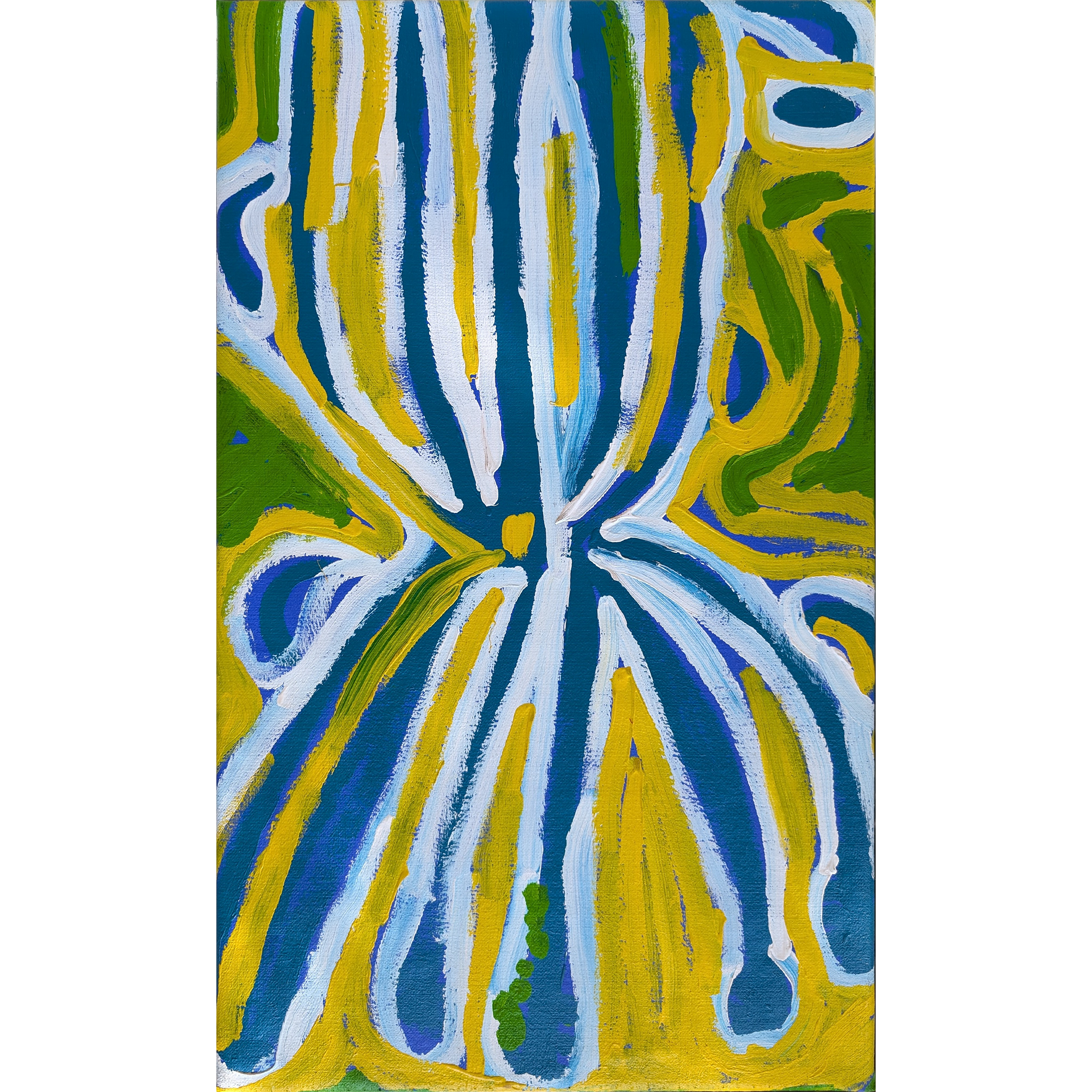
Artist: Pirrmangka Napanangka | Title: Tjintjintjin | Year: 2000 | Medium: Synthetic polymer on Belgian linen | Dimensions: 153 x 91cm
PRICE
Price available upon request. Please contact Adrian at adrian@newsteadart.com for details.
PROVENANCE
Papunya Tula Artists, NT Cat No. PN20000663
Tjala Aboriginal Art, NSW
Coo-ee Art Gallery, NSW
Accompanied by an original certificate of authenticity from Papunya Tula Artists.
ARTWORK STORY
This painting depicts designs relating to the site of Tjintjintjin, west of Kintore community. There is a series of rockholes at this site which are represented in the painting by the roundels. There is also an underground cave at this site. In ancestral times an old lady travelled to Tjintjintjin from Malparinga, north-west of the Kintore community. She also visited the soakage water sites of Ngatanga and Yaranga, which are all west of Mantati Outstation, approximately seventy kilometres west of the Kintore Community. She then travelled further east to Muruntji, south-west of Mt Liebig. At Muruntji she was accosted by one of a group of boys so she chased them and caught all but the culprit, who managed to escape. She killed the others and cooked them in the fire. She then travelled to Kaltarra where she entered the earth.
Artist Profile
COMMUNITY/REGION
Kintore, NT
LANGUAGE
Pintupi
BIOGRAPHY
Pirrmangka Napanangka was a Pintupi woman who was born at Tjintjin in the area of Wilkinkarra (Lake Mackay) in about 1945. She was brought to Haasts Bluff with the rest of her family by the Northern Territory Welfare Branch Patrol. Her mother was the formidable artist Inyuwa Nampitjinpa, her father was Tutuma Tjapangati, one of the original painting group at Papunya where the painting movement started and was also a very highly regarded painter. Her sister, Walangkura Napanangka, was also an extremely fine artist who painted for Papunya Tula Artists. Pirmmangka and Walangkura both painted the stories of the Two Women, Kungka Kutjara. Both of their styles display a similarity of expression in their depictions of their traditional stories. The colours in their art are both bold and harmonious and all three women showed a masterly sense of design. Pirrmangka is in the collections of the National Gallery of Victoria, University of Canberra, Chandler Collection, Artbank and the Araluen Art Centre, Alice Springs.
REFERENCES
Biography from certificate of authenticity by Tjala Aboriginal Art
PRICE
Price available upon request. Please contact Adrian at adrian@newsteadart.com for details.
PROVENANCE
Papunya Tula Artists, NT Cat No. PN20000663
Tjala Aboriginal Art, NSW
Coo-ee Art Gallery, NSW
Accompanied by an original certificate of authenticity from Papunya Tula Artists.
ARTWORK STORY
This painting depicts designs relating to the site of Tjintjintjin, west of Kintore community. There is a series of rockholes at this site which are represented in the painting by the roundels. There is also an underground cave at this site. In ancestral times an old lady travelled to Tjintjintjin from Malparinga, north-west of the Kintore community. She also visited the soakage water sites of Ngatanga and Yaranga, which are all west of Mantati Outstation, approximately seventy kilometres west of the Kintore Community. She then travelled further east to Muruntji, south-west of Mt Liebig. At Muruntji she was accosted by one of a group of boys so she chased them and caught all but the culprit, who managed to escape. She killed the others and cooked them in the fire. She then travelled to Kaltarra where she entered the earth.
Artist Profile
COMMUNITY/REGION
Kintore, NT
LANGUAGE
Pintupi
BIOGRAPHY
Pirrmangka Napanangka was a Pintupi woman who was born at Tjintjin in the area of Wilkinkarra (Lake Mackay) in about 1945. She was brought to Haasts Bluff with the rest of her family by the Northern Territory Welfare Branch Patrol. Her mother was the formidable artist Inyuwa Nampitjinpa, her father was Tutuma Tjapangati, one of the original painting group at Papunya where the painting movement started and was also a very highly regarded painter. Her sister, Walangkura Napanangka, was also an extremely fine artist who painted for Papunya Tula Artists. Pirmmangka and Walangkura both painted the stories of the Two Women, Kungka Kutjara. Both of their styles display a similarity of expression in their depictions of their traditional stories. The colours in their art are both bold and harmonious and all three women showed a masterly sense of design. Pirrmangka is in the collections of the National Gallery of Victoria, University of Canberra, Chandler Collection, Artbank and the Araluen Art Centre, Alice Springs.
REFERENCES
Biography from certificate of authenticity by Tjala Aboriginal Art






